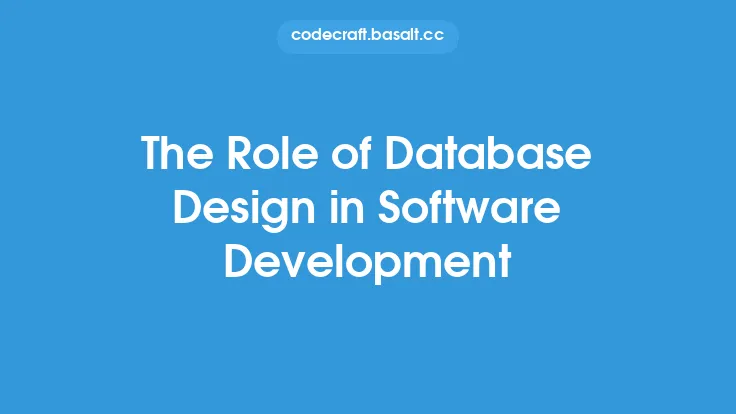Abstraction is a fundamental concept in software design that enables developers to create complex systems by breaking them down into manageable, modular components. It involves hiding the implementation details of an object or system and only exposing the necessary information to the outside world. This concept is crucial in software design as it allows developers to focus on the essential features and behaviors of a system, without getting bogged down in the intricacies of its internal workings.
Introduction to Abstraction
Abstraction is a key principle of software design that helps developers to create robust, maintainable, and scalable systems. It involves defining an interface or a contract that specifies how an object or system can be interacted with, without revealing the underlying implementation details. This interface serves as a layer of abstraction, decoupling the dependent components and allowing them to evolve independently. Abstraction enables developers to create complex systems by composing smaller, more manageable components, each with its own abstract interface.
Benefits of Abstraction
The benefits of abstraction in software design are numerous. Firstly, it enables developers to create modular systems, where each component can be developed, tested, and maintained independently. This modularity makes it easier to modify or replace individual components without affecting the entire system. Abstraction also facilitates code reuse, as components with well-defined abstract interfaces can be easily integrated into different systems. Additionally, abstraction helps to reduce complexity by hiding the implementation details of a system, making it easier to understand and interact with. Finally, abstraction enables developers to create more flexible and adaptable systems, as changes to the implementation details of a component do not affect its abstract interface.
Types of Abstraction
There are several types of abstraction in software design, each serving a specific purpose. Data abstraction involves hiding the implementation details of data structures and only exposing the necessary information to the outside world. Control abstraction, on the other hand, involves hiding the implementation details of control structures, such as loops and conditional statements. Procedural abstraction involves hiding the implementation details of procedures or functions, while functional abstraction involves hiding the implementation details of functions or methods. Each type of abstraction serves to decouple dependent components and enable more modular, maintainable, and scalable systems.
Abstraction Techniques
Several techniques can be used to achieve abstraction in software design. One common technique is the use of abstract data types (ADTs), which define a set of operations that can be performed on a data structure, without revealing its implementation details. Another technique is the use of interfaces, which define a contract or a set of methods that must be implemented by a class or component. Encapsulation is also a key technique for achieving abstraction, as it involves hiding the implementation details of an object or system and only exposing the necessary information to the outside world. Finally, polymorphism is a technique that enables objects of different classes to be treated as objects of a common superclass, further enabling abstraction and modularity.
Real-World Examples of Abstraction
Abstraction is a fundamental concept in software design, and its applications are numerous. For example, a database abstraction layer can be used to decouple an application from a specific database implementation, enabling the application to work with different databases without modification. Similarly, a file abstraction layer can be used to decouple an application from a specific file system implementation, enabling the application to work with different file systems without modification. In object-oriented programming, abstraction is used to define classes and objects that can be composed to create complex systems. For instance, a `Vehicle` class can be defined as an abstract class, with concrete subclasses such as `Car` and `Truck`, each with its own implementation details.
Best Practices for Abstraction
To effectively apply abstraction in software design, several best practices must be followed. Firstly, the abstract interface of a component must be well-defined and stable, to enable dependent components to rely on it. Secondly, the implementation details of a component must be hidden from the outside world, to enable changes to be made without affecting dependent components. Thirdly, abstraction must be applied consistently throughout a system, to enable modularity and maintainability. Finally, abstraction must be balanced with the need for performance and efficiency, as excessive abstraction can lead to overhead and complexity.
Common Pitfalls of Abstraction
While abstraction is a powerful technique for creating modular and maintainable systems, it can also lead to common pitfalls if not applied carefully. One common pitfall is over-abstraction, where the abstract interface of a component is too complex or convoluted, making it difficult to understand or use. Another pitfall is under-abstraction, where the implementation details of a component are not sufficiently hidden, making it difficult to modify or replace the component without affecting dependent components. Finally, abstraction can also lead to the "leaky abstraction" problem, where the abstract interface of a component is not sufficient to hide the implementation details, leading to tight coupling and fragility.
Conclusion
In conclusion, abstraction is a fundamental concept in software design that enables developers to create complex systems by breaking them down into manageable, modular components. By hiding the implementation details of an object or system and only exposing the necessary information to the outside world, abstraction enables developers to focus on the essential features and behaviors of a system, without getting bogged down in the intricacies of its internal workings. By applying abstraction techniques such as abstract data types, interfaces, encapsulation, and polymorphism, developers can create more modular, maintainable, and scalable systems. However, abstraction must be applied carefully, following best practices and avoiding common pitfalls, to ensure that the benefits of abstraction are fully realized.





